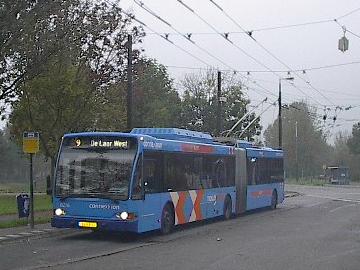Trolleybus
|
|

A trolleybus (also known as electric bus, trolley bus, trolley coach, trackless trolley, trackless tram or simply trolley) is a bus powered by two overhead electric wires, from which the bus draws electricity using two trolley poles. Two poles are required in order to accommodate the return current, which can not pass to the ground as in the case of an electric tram or streetcar since trolleybuses use rubber tires rather than steel wheels on rail.
A trolleybus is called a "trackless tram (無軌電車)" in China.
| Contents |
Background
The trolleybus's development dates to the early 1900s, when they seemed to be a natural compromise between the electric streetcar and the petroleum-powered bus. Trolleybus systems could avoid obstacles in the street which a streetcar could not, and did not require as much capital investment as a streetcar line.
Some cities, led by the Brooklyn-Manhattan Transit Corporation (BMT—New York), subscribed to the all-four concept of using buses, trolleybuses, trams (in U.S. called streetcars, trolleys or light rail) and rapid transit subway and/or elevated lines (metros) as appropriate for routes ranging from lightly-used to heaviest trunk line. Buses and trolleybuses in particular were seen as entry systems that could later be upgraded to rail as appropriate. Although the Brooklyn system under the BMT built only one trolleybus line, other cities, notably San Francisco, California and Philadelphia, Pennsylvania, built larger systems and still maintain "all-four". If you include cable cars as another mode, San Francisco could be called "all-five," as the cable cars do provide a general transportation function in addition to being a tourist attraction.
Advantages
Trolleybus4120.Harvard.agr.JPG
Trolleybuses are particularly important in hilly cities, as the electric power is more effective than diesel in climbing steep hills and trolleybuses' rubber tires have better roadway adhesion than streetcars' steel wheels upon steel rails. This is especially important in hilly cities such as San Francisco and Seattle, USA.
Like other electric vehicles, trolleybuses are often seen as more environmentally friendly than hydrocarbon-based vehicles (gasoline, diesel, alcohol, etc.), but the power is not "free", and instead has to be produced at centralised power plants, with its attendant transmission losses. On the other hand, centrally-produced power has the advantage of being more efficient, not bound to a specific fuel source, and more amenable to pollution-control as a single-source supply than individual vehicles, each with its own power generation and each exhausting noxious gases and particulates at street level.
One advantage that is rarely used in other vehicles is that they can generate electric power from kinetic power whilst braking or going downhill, a process known as regenerative braking.
Another area where trolleybuses enjoy a special niche is locations where hydropower is abundant and cheap. Examples of this are the extensive trolleybus systems in Vancouver, British Columbia, Canada and Seattle, Washington, USA. The last city doubly benefits, due to the steep road grades near the Downtown waterfront as well as on Queen Anne, First, and Capitol Hills.
Some have suggested that the trolleybus will become obsolete in a future hydrogen economy. However direct electric transmission, as used in trolleybuses, is far more efficient (by a factor of two or more) than conversion of energy into hydrogen, transportation and storage of the hydrogen and its conversion back into electricity by fuel cells.
China is experimenting a new form of electric bus that runs without powerlines. This bus runs on power stored in large onboard capacitors, which are quickly recharged whenever the electric bus stops in any bus stop. A few prototypes are being tested in Shanghai as of early 2005.
Problems with Trolleybuses
Us-san-francisco-trolleybus.jpg
As trolleybuses do not follow a track, it is possible for them to come off the route and hence off the electric powerlines above and then get stuck. Some transit systems, such as Muni in San Francisco, have gotten around this problem by installing battery packs on their trolleybuses to allow them to drive for short distances in case they cannot follow the standard route. Boston is using dual-mode buses on its new Silver Line that run on overhead electricity on a fixed right of way and then transition to city streets using diesel power.
In more general terms, trolleybuses suffer from being "neither fish nor fowl" in current transportation planning. Except in the cases mentioned above where they have special advantages, they have difficulty competing with the efficiencies of light rail on the one hand, or the flexibility and low start-up costs of conventional buses on the other.
While at one time numerous cities operated this mode of transport, it is uncommon today in North America and not expanding in Europe, though it is still a common form of transport in the former Soviet republics, generally occupying the niche between street railways and diesel-powered buses.
Public_Transfer_TrolleyBus_Bratislava.jpg
Preservation
They are often preserved in museums like the East Anglia Transport Museum in England.
See also
- List of cities with trolleybuses for cities which still have trolleybuses
- List of cities that no longer have trolleybuses
- Overhead lines
External links
- The Electric Trolleybus Web Site (http://members.shaw.ca/dearmond/)
- Budapest Trolleybuses (http://trolibusz.budapest.hu)
- Transport Photogallery (http://ams1.lo3.wroc.pl/tomek/)
- Pictures of Trolleybusses in (http://www.nets.pl/~skwar709/trolleya.htm) Gdynia
- British trolleybuses (http://www.trolleybus.co.uk/)
- Arnhem Trolleystad (http://www.arnhem.nl/)
References
- All Time List of North American Trolleybus Systems (http://home.cc.umanitoba.ca/~wyatt/etb-systems.html), accessed January 30, 2004
- British trolleybuses (http://www.trolleybus.co.uk/|)Template:Commons
de:Oberleitungsbus fr:Trolleybus es:Trolebús nl:Trolleybus ja:トロリーバス no:Trolleybuss pl:Trolejbus ru:Троллейбус sk:Trolejbus sl:Trolejbus fi:Johdinauto sv:Trådbuss tt:Trolleybus zh:無軌電車
